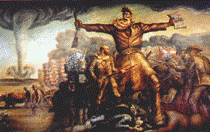History, Department of

James A. Rawley Graduate Conference in the Humanities
Date of this Version
April 2008
Document Type
Article
Abstract
Town building in the Great Plains during the 19th century centered on railroads. Railroads were promoted as the means for fiscal success through direct and ancillary sources. When railroads did not transpire in the manners expected, towns sometimes resorted to drastic measures to lure railroads. These drastic measures could, and did, backfire as in the case of Brownville, Nebraska.
Located in southeastern Nebraska, Brownville offers an interesting study in the manner railroads affected town development. Planning, attempting and ultimately failing to entice railroads proved devastating to the town. The actions taken to get an effective railroad eventually led to lawsuits, increased property taxes, loss of the county seat and subsequent population decline.
Railroads offered progress and purpose for many towns in the Great Plains during the nineteenth century, but definitely not all. Towns in the Great Plains suffered when blinded by their dreams of greatness, they fell prey to designs of being the next metropolis, losing what little they had. Enticing the Iron Horse proved counter productive to town building efforts when they failed. Railroads thus affected town development, not just where railroads intersected towns, but where towns could not lure the iron horse.


Comments
Paper presented at the 3rd Annual James A. Rawley Conference in the Humanities — Imagining Communities: People, Places, Meanings. Lincoln, Nebraska, April 12, 2008. Sponsored by the University of Nebraska–Lincoln History Graduate Students’ Association. Copyright © 2008 Robert Voss.